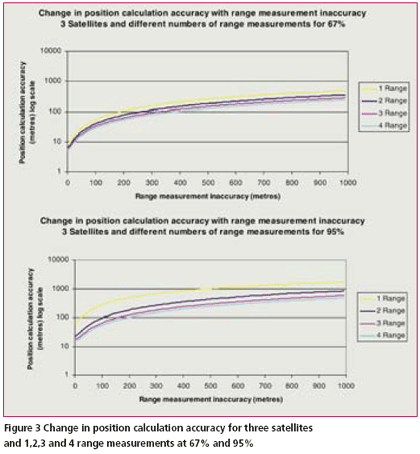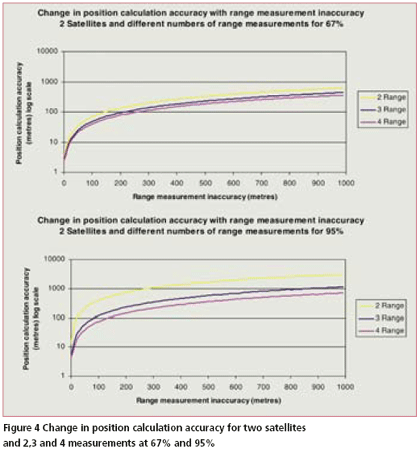| LBS | |
Using Assisted-GNSS to locate handsets in wireless networks
Hybrid A-GNSSThere are several advantages of performing the position calculation on the server (handset-assisted AGNSS) [9]. One of the advantages is that there is opportunity to include additional range measurements that the server can obtain from the network into the position calculation. This can improve both the yield and accuracy of the location solution. When the handset is in an area where its view of the sky is obscured it may not be able to lock onto the minimum number of satellites to perform a position calculation. In this case the other range measurements may permit a position to be calculated when otherwise there would be none. In the case where there is more than the minimum number of satellites in view, additional measurements provide increased measurement redundancy and hence improve yield and accuracy by making the position calculation less susceptible to bad measurements. The accuracy of range measurements depends on the radio technology and their sources. Range measurements are generally either calculated from signal strengths measured from a known source in combination with a propagation model, or are determined from timing measurements associated with known signals arriving from a known source They could be Timing Advance (TA) in a GSM network, Uplink Time Difference of Arrival (UTDOA) time difference measurements, WiFi or Digital TV (DTV) ranging signals. When incorporating these range measurements into the position calculation algorithm, the accuracy of the measurement needs to be considered so that it doesn’t make the location worse. Some results of position calculation accuracy with simulated range measurements are shown in Figure 3 and Figure 4. Here the case where there are not enough satellite measurements to do a complete GPS solution is considered. GPS data was collected over a complete day from a GPS receiver on the roof of the laboratory and consists of 80,657 distinct epochs. In order to simulate a situation where only three satellites are in view (which is the case in Figure 3), three satellites are randomly selected from each epoch and range measurements are introduced with varying levels of inaccuracy. These simulated range measurements show how the accuracy of the overall position calculation is influenced by errors in the range measurements across a whole day of GPS data. The position calculation function used for experiments is a parametric weighted least squares implementation where range measurements are considered as another input to the solution with appropriate weighting in the stochastic model. Figure 3 shows the effect of the error in the position calculation when there are only three satellites in view of the receiver and there are different numbers of simulated range measurements of varying inaccuracies. It shows that when there are only 3 satellites and 1 accurate range measurement there is less than 10 metres of error over a complete day of data for 67% of the data and just over 10 for 95%. As the inaccuracy of the range measurement increases the distance of the calculated location from the ground truth increases. For example, GSM TA has accuracy in the vicinity of 550 metres. So that would result in a position accuracy of over 100m at the 67% level. Similarly, Figure 4 shows the results of using only two satellites and 2,3 and 4 range measurements. In this case the position accuracy follows a similar curve and the accuracy of the location is highly dependant on the accuracy of the range measurements. ConclusionWireless standards for A-GPS are mature and are in general use. SUPL positioning bypasses traditional telecommunications and allows a handset to talk directly with the SLP. This makes network interoperability simpler and is a platform that is likely to get wide acceptance. Standards bodies are presently considering the integration of GNSS information in order to facilitate use of the other GNSSs. This will lead to more satellites being available to the handset and an improved yield and accuracy for the position calculation. Hybrid A-GNSS is a viable solution for improving yield when there are not suffi cient satellites visible. The accuracy of the resulting location depends on the accuracy of the additional range measurements and how they are integrated into the position calculation function. It is equally applicable to control plane or user plane location architectures. References[1] Federal Communications Commission (FCC) OET Bulletin 71, Guidelines for Testing and Verifying the Accuracy of Wireless E911 Location Systems, April 12th 2000 [2] TR-45 Enhanced Wireless PN- 3890-RV2 9-1-1 Phase II J-STD-036 [3] 3GPP TS 44.031, “Location Services (LCS); Mobile Station (MS) – Serving Mobile Location Centre (SMLC) Radio Resource LCS Protocol (RRLP)”, URL: http://www.3gpp.org/ [4] 3GPP TS 25.331, “Radio Resource Control (RRC) Protocol Specifi cation” URL: http://www.3gpp.org/ [5] 3GPP2 C.S0022-0 v3.0, Position Determination Service for cdma2000 Spread Spectrum Systems; April 2001 [6] 3GPP2 C.S0022-A v1.0: “Position Determination Service Standard for Dual Mode Spread Spectrum Systems” March 2004 URL: http://www.3gpp.org/ [7] OMA Secure User Plane Location (SUPL) Architecture [8] OMA UserPlane Location Protocol (ULP) [9] Harper, N., Nicholson, P., Mumford, P., Poon, E., 2004, Process for improving GPS acquisition assistance data and server-side location determination for cellular networks,Journal of Global Positioning Systems, Vol 3., No. 1-2, 2004 http:// www.cpgps.org/journals.php |
||||||||||||
|
Pages: 1 2















 (No Ratings Yet)
(No Ratings Yet)




